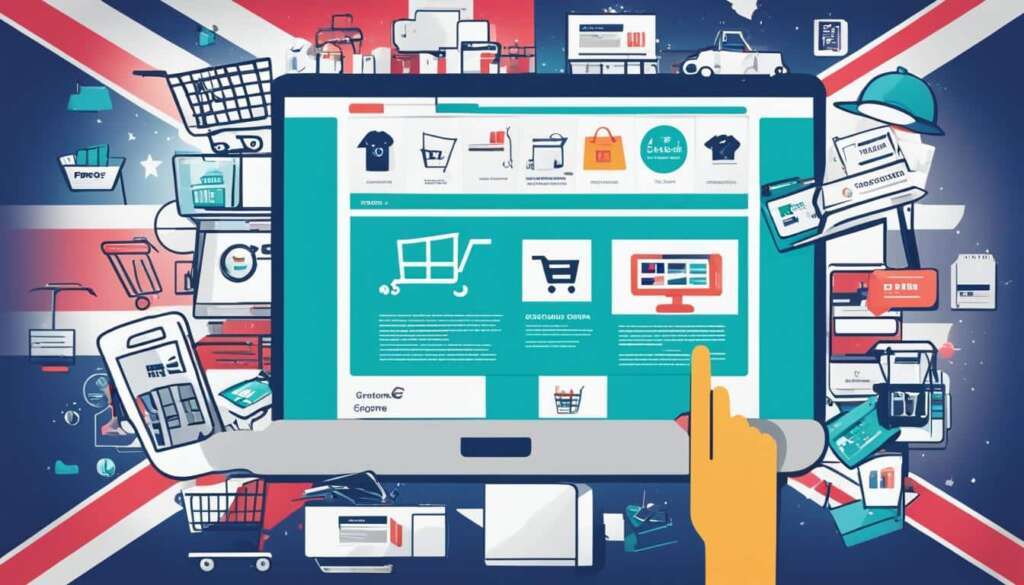Table of Contents
The future of e-commerce in the UK is influenced by various trends and factors. In this article, we will explore the key insights and growth projections for the e-commerce industry in the UK for the year 2023. By analyzing data from multiple sources, we aim to provide an in-depth analysis of the current trends and consumer behavior driving the e-commerce market in the UK.
The Impact of Inflation on Online Spending
With the current economic climate and soaring inflation, UK households are increasingly turning to online shopping while cutting back on non-essential purchases. The average amount spent online has seen an 11% increase in Q1 2023 compared to Q1 2022. This trend favors essential categories such as food and home appliances, while fashion and electronics spending has declined. This shift in consumer behavior reflects the need for consumers to make trade-offs in their spending habits amidst inflationary pressures.
The Rise of Second-Hand Shopping
The second-hand market in the UK has experienced significant growth, with the penetration rate increasing from 16% in 2020 to 23% in 2022. This trend is driven by both environmental and economic reasons as consumers seek sustainable and affordable options.
Environmental concerns play a major role in the rise of the second-hand market. With increasing awareness about the impact of fast fashion and disposable consumerism, more people are choosing to buy second-hand to reduce waste and promote a circular economy. By giving pre-loved items a second life, consumers contribute to reducing their carbon footprint and conserving resources.
Economic factors also play a crucial role in the popularity of second-hand shopping. Buying second-hand allows consumers to save money by purchasing items at lower prices compared to buying new. With rising living costs and economic uncertainties, many individuals are turning to the second-hand market to stretch their budgets without compromising on quality.
While younger generations have been at the forefront of the second-hand shopping trend, there is a growing adoption among Generation X. This shift in consumer behavior presents significant opportunities for businesses to tap into the second-hand market and cater to a wider demographic.
The Benefits of Second-Hand Shopping:
- Reduced environmental impact
- Cost savings
- Unique and vintage finds
- Supporting local businesses and charities
- Reducing demand for fast fashion
Overall, the rise of second-hand shopping in the UK is driven by a combination of environmental concerns and economic motivations. As consumers increasingly prioritize sustainability and affordability, businesses in the e-commerce sector have the opportunity to capitalize on the growing second-hand market.
TikTok Shop and the Beauty Market
The launch of TikTok Shop in the UK has had a significant impact on the beauty market. This social media platform’s entry into the e-commerce space has revolutionized the way consumers discover and purchase beauty products.
With a higher average order value (AOV) and a greater number of purchases compared to the average beauty shopper, TikTok Shop has quickly established itself as a major player in the industry. In fact, it has captured a remarkable 17% of customers’ online beauty budgets, positioning itself as the second largest channel, only behind Amazon.
What sets TikTok Shop apart is its ability to leverage user-generated content and influencer marketing to promote beauty products. By collaborating with popular TikTok creators and showcasing their favorite beauty products, the platform creates a unique and engaging shopping experience for its users.
Consumers are drawn to TikTok’s algorithm-driven content, which tailors product recommendations based on their interests and preferences. This personalized approach has proven to be highly effective in influencing purchasing decisions. As a result, beauty brands have quickly recognized the value of partnering with TikTok and utilizing its vast user base.
TikTok Shop’s success in the beauty market underscores the growing influence of social media platforms in shaping e-commerce sales. As the beauty industry continues to evolve, brands should consider incorporating TikTok into their marketing strategies to reach a wider audience and tap into the platform’s engaged user base.

“TikTok Shop has revolutionized the way consumers discover and purchase beauty products.”
The Impact of Strong Customer Authentication (SCA) on Payments
The implementation of Strong Customer Authentication (SCA) requirements across Europe has brought significant changes to online payments. With SCA, customers are required to provide two or more forms of authentication, such as a password, biometric data, or a unique code, to ensure secure transactions. This additional layer of security aims to protect consumers and reduce fraud.
As a result of SCA, consumers now have different preferences for payment methods. Traditional methods like credit and debit cards, bank transfers, and e-wallets are still widely used, but there is a growing demand for alternative payment options as well.
One such option is the “Buy Now Pay Later” (BNPL) service, which allows customers to make purchases and delay the payment. BNPL providers offer flexible installment plans, often interest-free, making it an attractive choice for budget-conscious shoppers. The convenience and affordability of BNPL have contributed to its increasing popularity, especially among younger consumers.
Europe leads the world in BNPL adoption, with 8% of e-commerce sales relying on instant-loan options. This trend is fueled by the convenience, financial flexibility, and transparent pricing models offered by BNPL providers. Businesses that integrate BNPL into their payment offerings can attract more customers and boost sales.
However, the shift in payment preferences poses both challenges and opportunities for businesses in the e-commerce sector. On one hand, adopting SCA requirements can lead to smoother and more secure transactions, enhancing customer trust and loyalty. On the other hand, businesses need to ensure they offer a wide range of payment methods to cater to diverse customer preferences and capture every sale opportunity.
The table below illustrates the popularity of different payment methods in Europe:
| Payment Method | Percentage of E-commerce Sales |
|---|---|
| Credit/Debit Cards | 62% |
| Bank Transfers | 15% |
| E-wallets | 10% |
| BNPL | 8% |
| Other | 5% |
The Returns Reckoning in E-Commerce
As online shopping continues to gain momentum, the e-commerce industry is grappling with a significant challenge: returns. In the past, returns were often seen as an inconvenience, but today, they have become an integral part of the shopping process. Consumers have grown accustomed to the convenience and flexibility of returning items they have purchased online.
However, the surge in returns has prompted retailers to implement return fees in order to manage the associated costs. This strategic move aims to strike a balance between customer satisfaction and the financial implications of an increasing number of returns. Retail giants like Zara and Boohoo have introduced return fees to mitigate the impact of returns on their bottom line. Additionally, industry leader Asos has been transparent with its investors, acknowledging the potential impact of returns on annual profits.
In the face of this returns reckoning, businesses are now focusing on strategies to handle returns more effectively. It is crucial for retailers to strike a balance between reducing return rates and maintaining a positive customer experience. By streamlining return processes, optimizing packaging, and enhancing product descriptions, retailers can minimize the number of returns caused by false claims or buyer’s remorse.
“Returns have become an important aspect of online shopping. To continue thriving in this ever-evolving e-commerce landscape, businesses need to find ways to manage returns efficiently and provide customers with a seamless return experience.”

Conclusion
In conclusion, the e-commerce industry in the UK is experiencing rapid growth and transformation, spurred by various trends and factors. The impact of inflation on online spending has reshaped consumer behavior, with a shift towards prioritizing essential purchases over non-essential ones. Moreover, the rise of second-hand shopping has gained momentum, driven by both environmental and economic considerations. This presents businesses with opportunities to tap into the growing second-hand market.
Additionally, the introduction of TikTok Shop has revolutionized the beauty market, as social media platforms increasingly influence consumer purchasing decisions. We have also witnessed changes in payment preferences due to the implementation of Strong Customer Authentication (SCA) requirements. This has led to the rise of “Buy Now Pay Later” (BNPL) options, which businesses need to consider for seamless payment experiences.
Lastly, managing returns has become a critical challenge for e-commerce retailers. With the surge in online shopping, businesses must find effective ways to handle returns while addressing false claims and implementing return fees. By staying informed about these e-commerce trends and understanding consumer behavior, businesses in the UK market can stay competitive and capitalize on the numerous growth projections in the dynamic e-commerce landscape.
FAQ
How has inflation affected online spending in the UK?
Inflation has led to an increase in online spending for essential purchases while non-essential purchases have been cut back.
What is driving the growth of the second-hand market in the UK?
The growth of the second-hand market is driven by environmental and economic factors as consumers seek sustainable and affordable options.
What impact has TikTok Shop had on the beauty market in the UK?
TikTok Shop has captured 17% of customers’ online beauty budgets, making it the second-highest influencer after Amazon.
How has Strong Customer Authentication affected payment preferences in Europe?
Strong Customer Authentication has led to changes in payment methods and an increase in the popularity of “Buy Now Pay Later” options.
How are returns impacting the e-commerce industry?
Returns have increased, leading retailers to implement return fees and tackle false claims, posing challenges for businesses.







